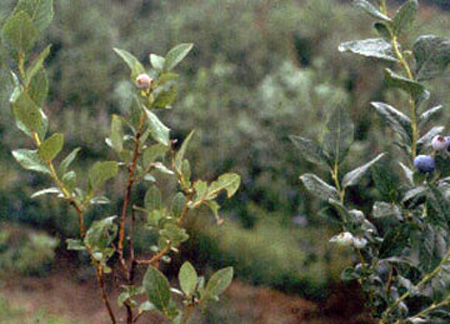Nitrogen deficiency (N deficiency)
Nitrogen deficiencies are common in blueberries. Note the light green color (chlorosis) is uniform across the leaves with no particular pattern or mottling. Other symptoms of nitrogen deficiency include reduced shoot growth, numbers of new canes and yield. Nitrogen deficient leaves may develop early fall color and then drop off.

Iron deficiency (Fe deficiency)
Interveinal yellowing is caused by iron deficiency, but is symptomatic of high soil pH. A high soil pH (>5.2) results in the inability of the blueberry plant to use iron, causing a lack of chlorophyll production.

Iron deficiency symptoms develop first in young leaves. Lowering the pH with sulfur will usually correct the problem.

Potassium deficiency (K deficiency)
Potassium deficiency results in marginal leaf burn. It is not common, but has been observed in very sandy soils.

Phosphorus deficiency (P deficiency)
causes purple coloration in blueberry leaves, but this is rarely observed in the field. Blueberries have a low P requirement. If the pH is too high (>5.2) for adequate P uptake, other nutrients likely will be unavailable as well.

Magnesium deficiency (Mg deficiency)
Mangnesium deficiency is common in acid soils. Lack of Magnesium causes interveinal reddening because chlorophyll production is reduced. Symptoms begin as an interveinal yellowing and progress to a bright red. Leaves at the bases of young shoots are most likely to exhibit symptoms first. Young leaves at the tips of shoots are seldom affected.

Boron deficiency (B deficiency)
In rare cases, boron deficiency causes die back of canes without wilting or cankers present. A leaf analysis can verify this diagnosis.

More information:
- Blueberry nutrition – Michigan State University Extension
Suspected nutrient deficiencies can be verified with a soil and/or foliar analysis done through Agro-One.
Use these resources if you need additional help with diagnosis and to find solutions to your problem.


